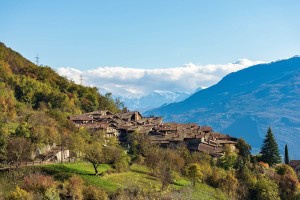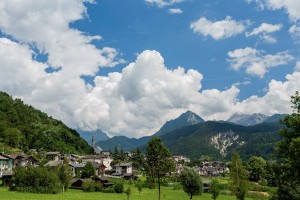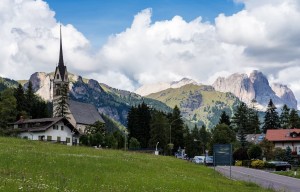
©Bigstock.com/Alberto SevenOnSeven
Autonomy plays a key role in Trentino. The Second Autonomy Statues in 1972 transferred the autonomy of the Trentino-Alto Adige/Südtirol region to its two provinces, giving Trentino the official name Autonomous Province of Trento. Beyond the eponymous capital there’s a whopping 166 municipalities surrounded by numerous imposing mountains and ski areas, such as the world-famous Madonna di Campiglio. Furthermore, more than a third of Trentino counts as protected landscape including one national park, two nature parks, 143 Natura 2000 nature protection areas and 265 biotopes. This natural splendour goes hand in hand with old village structures of outstanding beauty, both on the mountains and in the valleys. Look forward to very charming places as part of the private association “I borghi più belli d’Italia.” The eight most beautiful places in the Autonomous Province of Trento are most certainly worth a visit.
Bondone
A veritable labyrinth of asphalted roads awaits you in this charming place. You can easily get lost in Bondone (approx. 640 inhabitants). Plenty of frescoes with religious motives on house walls reflect the erstwhile devoutness of the population. However, several satirical depictions have been smuggled among them – can you find them all during a walk? Find Castello San Giovanni, an 11th century castle likely built on ancient Roman structures, a bit outside of Bondone. Having been owned by the noble Lodron family for centuries, it was restored to its old look during renovations in the 1950s.
Canale di Tenno
Less than 50 people currently live in the smallest, probably most beautiful part of the municipality Tenno. First documented in the early 13th century, Canale hardly changed and still has this exclusively medieval look to it. Tightly interlaced houses lead you across the southern hill of Monte Misone. Today, many painters and artists call Canale di Tenno their home finding plenty of inspiration in the classical, more often than not particularly quiet atmosphere of this place. This changes in early August when the annual Rustico Medioevo, a one-week medieval event, takes places in Canale. One of Italy’s most beautiful places turns into a hotspot for theatre performances, for art and for regional cuisine.
Luserna
Find a bastion of an almost extinct Southern Bavarian dialect in the south of Trentino. There are only about 1,000 people in the world who still speak Cimbrian. Many of them live in Luserna (approx. 270 inhabitants) where about 90% of the population speak this dialectal variety. German settlers like came to the region when well-educated carpenters and wood carvers were needed. It won’t come as much of a surprise that Luserna takes great care of maintaining its traditions. There’s a large documentation centre that regularly organises exhibitions concerning the language, culture and history. The delightfully alpine charm of the many small houses is quite enchanting. Two hiking trails lead through and around Luserna illustrating its history, accompanied by art installations.

©Bigstock.com/Tatyana Abramovich
Mezzano
Charming Mezzano (approx. 1,600 inhabitants) awaits you in the heart of an almost completely green valley floor on the foot of the Pale di San Martino, part of the UNESCO World Natural Heritage Dolomites. While there certainly may be many an interesting building, such as the 14th century parish church San Giorgio, the architectural uniformity, the charming idyll, the naturalness are what makes this place so special. Many narrow roads that were originally established for agricultural vehicles, small squares with fountains, religious frescoes and magnificent gardens create a lovely village scenery. 20 murals, more than 100 wall inscriptions, the well-thought-out water system and about 400 gardens provide plenty of enticing reasons to visit Mezzano.
Pieve Tesino
Early settlements around this magnificent place (approx. 640 inhabitants) can be traced back to the Bronze Age. Numerous castles and settlements developed in later periods due to the proximity to a Roman road. Pieve Tesino itself, however, was founded in post-Christian times. Its diverse architecture invites you on a little journey through time with a mountainous backdrop. Among the oldest buildings are the 12th church Pieve dell’Assunta, restored in 1872, which is among the grandest and most important Gothic buildings in Trentino. Discover 16th century frescoes on its southern façade. There’s a slightly younger, equally impressive church on the Colle di San Sebastiano. Several museums, gardens and themed paths are dedicated to local and Italian history.
Rango
Despite being part of Bleggio Superiore, the district Rango (approx. 120 inhabitants) is one of the most beautiful places in the Autonomous Province of Trento in its own right. Originally located at one of the major trade and transit routes, time has seemingly come to a stand-still in Rango. The architecture has hardly changed its function since the 18th century. Houses and stables mostly remained under the same roof, stone and hay protect the various structures. The mullioned windows illustrate the Renaissance influence on the overall look of the place. Numerous passages, so-called “vòlt,” used to be where village life took place. They now serve as a thrilling backdrop from another time with the valley and mountains as thrilling scenic additions.

©Bigstock.com/RudiErnst
San Giovanni di Fassa
Called Sèn Jan in Ladin, San Giovanni di Fassa (approx. 3.600 inhabitants) only came to be in 2018 when Pozza and Vigo merged. Most of its beauties can be found in the former Vigo in the heart of the wide and sunny Fassa Valley, surrounded by the mountain peaks of the Latemar and the Rosengarten group that turn pink in sunlight. There’s even a special word for the region’s unique beauty: “enrosadira” (“turning pink”), from the Ladin “enrosadöra.” Every district, every small village within the village has its own distinct character. Find a spectacular late Gothic church with belltower in Vigo, enjoy the charm of old houses and fountains in Costa, and experience the architectural atmosphere of Vallonga.
San Lorenzo in Banale
The terraced location of San Lorenzo makes this place of approx. 1,600 people the perfect panoramic platform across the wide valley with the Dolomites serving as a tall, craggy backdrop. Being lush and green in summer and mostly covered in heaps of snow in winter, the scenic beauty comes through particularly nicely. San Lorenzo in Banale was originally formed by the merger of seven so-called “villas.” Numerous extensively renovated buildings line your walk. They hide glorious frescoes and monumental halls behind its façades. The arcades and courtyards, however, bring Mediterranean charm to the Italian north, thereby creating a fascinating contrast to the alpine scenery.
Magically enticing natural sites and diverse architecture make the most beautiful places of the Autonomous Province of Trento stand out. Their variety impresses over and over again. Architectural magic ranging from the Middle Ages to now makes history palpable. Language minorities have their say, old traditions and customs are practiced, an abundance of walks and hiking trails can be found. Trentino is a fascinating province and perfect to closely experience a slightly different Northern Italy.